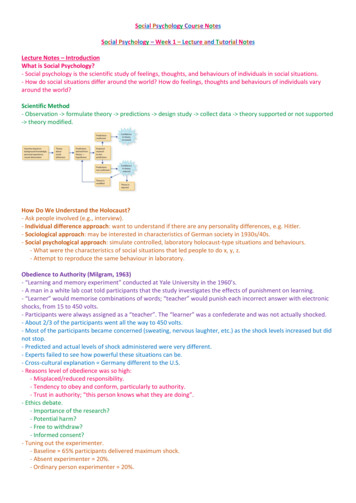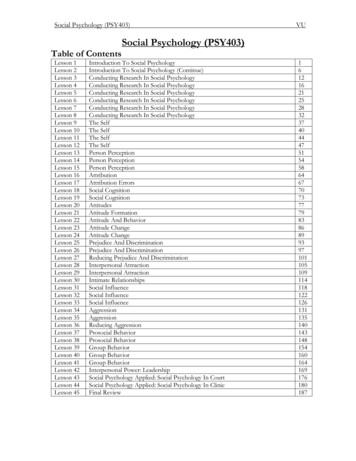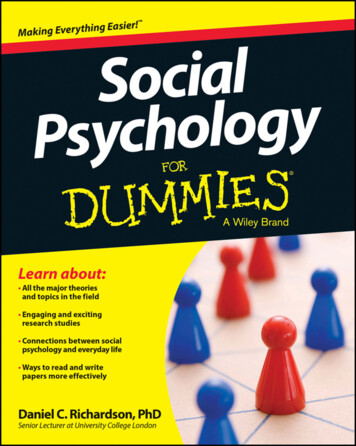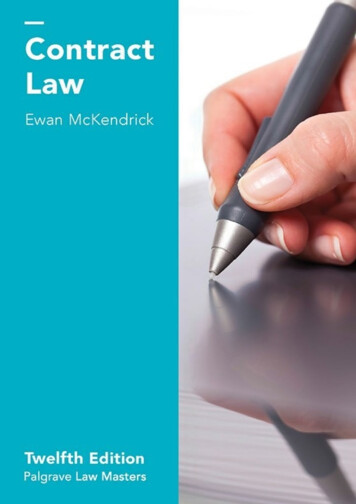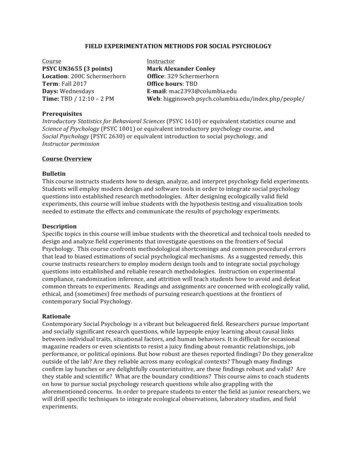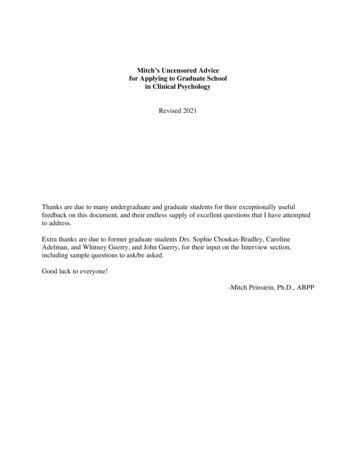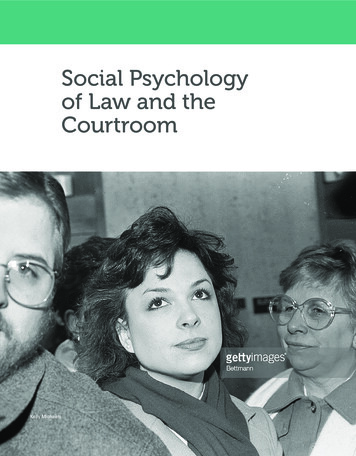
Transcription
Social Psychologyof Law and theCourtroomKelly Michaels
The case of Kelly Michaels demonstrates why reliability and validity show up inevery psychology textbook. They deserve to be integrated into your life. Her storyalso might inspire you to become a forensic psychologist.“It’s like public execution, but you stay alive to go at it again, and again, day afterday,” Kelly Michaels told Oprah Winfrey in 2003 (you can search for the interview onYouTube). It started when the police knocked on her door as the 23-year-old aspiringactress was getting ready for work at the Wee Care Day Care. Her name had been mentioned in a case of child sex abuse. The police took her for questioning and released herafter hearing her story. She thought the short nightmare was over. But they came backand accused her of playing the piano nude, “Making poopie cakes with the children,inserting silverware into the children just horrible things.”It became the longest trial in New Jersey history and cost multiple millions of dollars. And it was all an illusion. In the absence of direct physical evidence, the prosecution used anatomically correct dolls as they interviewed pre-school aged children aboutwhat had happened and where they had been touched. But here’s the catch. Most of theprosecution’s interviewers were biased to believe that Kelly Michaels had abused the children. For example, to confirm what they already believed, the detectives asked childrenleading questions such as, “Where could Miss Kelly have touched you?” The detectiveshad not been psychology majors, or they had forgotten what they had learned, becausethey did not recognize their own leading questions.Instead, the detectives believed that they were measuring what they intended tomeasure when children touched or played with the doll’s genitalia. They failed to consider that the children might have played with any unusual feature on a naked dollsimply because it was a novelty (see Bruck & Ceci, 2009). After three years of legalproceedings and millions of dollars, they still did not understand reliability, validity,or confirmation bias. They sent an innocent Kelly Michaels to prison for 47 years (sheserved five of them, until the decision was overturned).After reading this chapter, you will be able to answer the following questions:Core QuestionsLearning Objectives1.How do psychology and law fit together?1.2.What career opportunities unitepsychology and law?Apply the goals and methods of psychology to lawand courtroom situations.2.Compare and contrast various careers thatcombine psychology and applied law.HOW DO PSYCHOLOGYAND LAW FIT TOGETHER?Learning Objective 1: Apply the goals and methods of psychologyto law and courtroom situations.Forensic psychology is the application of psychological theory to legal processes. Thisrelatively wide subfield applies research and theory from many areas of psychology to awide variety of contexts. Six categories of application are shown in Table X.Some of these categories fit easily with standard training in psychology. For example, you are probably more prepared than you realize to start down a path of conductingSocial Psychology of Law and the Courtroom3
TABLE X.2 Applications of Forensic PsychologyArea or ContextInterrogationsExamplesEthics of lying to suspectsConfessionsLie riminal profilingCognitive errors and bias in police,lawyers, jurors, witnesses, etc.Person evaluationparticular kinds of assessments and program evaluation. However, as with many partnerships, the relationship between psychology and the law is sometimesboth intimate and contentious. It is intimate becauselaw and psychology seem to be working on the sameimportant social problem: individual and socialself-regulation (see Goldstein, 1968). But the relationship between them can become contentious becausetheir professional cultures often are in conflict. Manyof the attitudes, training experiences, and professionalvalues of lawyers and psychologists simply will not easily fit together.Jury selectionEyewitness identificationCompetency/sanity of defendantsTrauma assessmentRisk assessmentCommon Goals:Reliability and ValidityThe anatomically correct dolls that helped sendKelly Michaels to prison are part of a psychologicalFamily lawChild custodytest. The test is intuitively appealing, but it has twoDispute mediationways of being wrong. In this context, a false posiSexual abuseRelationship violencetive occurs when a therapist decides that a child hasbeen abused when he or she hasn’t. A false negativeWorkplaceHarassmentoccurs when a therapist decides that a child has notassessmentDiscriminationbeen abused when he or she has. In addition, thePolicy compliancetheoretical orientation of the therapist will lead toPolicy evaluationProgram evaluationdifferent interpretations. Refusing to touch the dollPrison sentencingcould indicate abuse to a Freudian who interpretsRehabilitationnot touching as repression or denial. However, playDeath penaltying enthusiastically with the doll could also be interpreted as signs of abuse.Using anatomically correct dolls to test small children for signs of sexual abuse waspopular for many years. But from the very beginning, there were concerns about itsreliability and validity (Friedemann & Morgan, 1985). In fact, the California SupremeCourt decided that it could not determine if using anatomically correct dolls was a validway to assess child sex abuse. So the court referred theproblem back to the scientific community (see Yates &Terr, 1988, p. 254), ruling that “use of the dolls . . . isadmissible in court only if it has been accepted as generally reliable in the scientific community.”Psychology and lawyers have similar goals thatinclude gathering evidence that is both reliable andvalid. In addition, both want the best for their clientsand both have some interest in promoting social justice. So it seems as if there ought to be some degreeof meaningful overlap – and there is. However, thepoints of contention are also fundamental to eachdiscipline.Consider a few archival case studies from both psychology and law.Anatomically correct dolls4SOCIAL PSYCHOLOGY
Different Philosophies:Advocacy Versus ObjectivityLaw generally determines what is right by virtue of precedent, or prior authority;psychology determines what is right by virtue of empirical observations. Law can onlyreact to and process ongoing events; psychology gets to choose what it studies. Thepractice of law is based on advocacy; the practice of psychology requires objectivity.Consequently, trying to fit psychology into law has often been difficult – and thistension between psychology and law has been present from their first interactions.Hugo Münsterberg. The relationship between psychology and the law got off to ashaky start. When psychologist Hugo Münsterberg published his book On the WitnessStand (1908), he was hoping to influence the legal system to accept evidence from psychology in the same way it accepted evidence from other branches of science. He wasunsuccessful. Costanzo and Krauss (2015, p. 2) described the book’s “icy reception fromlegal scholars.” One reviewer gave it a “savagely, satirical critique” for Münsterberg’s“exaggerated claims for psychology.” Even worse, the book was not well received byfellow psychologists.Louis Brandeis. The next occurrence was more promising. That probably wasbecause a future Supreme Court justice, Louis Brandeis, understood irrational humanpsychology better than Hugo Münsterberg understood the law. Brandeis cited socialscience as he argued in favor of improving wages and limiting the workday to 10 hours.The case of Muller v. Oregon (see Woloch, 1996) involved a woman working long hoursin a laundry factory. Brandeis argued from a social science perspective that excessivework hours produced negative social consequences such as infant mortality and childrenharmed by neglect.It was data more typical of sociology than psychology, but it was a start. In thesefirst two examples, the psychologist (Hugo Münsterberg) was trying to push psychology’sbig ideas through a very small door of legal acceptance. He was ineffective – maybe evencounterproductive. But the lawyer (Louis Brandeis) was trying to pull something relativelysmall (some social science data) through that same small door. His data were specific andlimited. He was much more effective – and his success created opportunities for others.Mamie Clark and Kenneth Clark. We introducedyou to the Clarks in Chapter X [FILL IN LATER] whenwe described Mamie Clark’s original Master’s thesis. Sheoriginated a series of studies that influenced the 1954Supreme Court case that ended legal school segregation,Brown v. Board of Education. But the consequences ofthat legal victory demonstrate critical differences in howpsychologists and lawyers define success.The lawyers who prevailed in Brown v. Board ofEducation were happy about their legal victory. Butthe Clarks were, over time, profoundly disappointedbecause so little changed. The lives of most of the children that they were trying to empower continued tosuffer from institutional and cultural discrimination.A longer view, if they had lived to see it, might havegiven the Clarks some comfort.Brown v. Board of EducationSocial Psychology of Law and the Courtroom5
Medieval tortureThe Social Psychology ofFalse ConfessionsKelly Michaels, from the chapter’s opening, told Oprah Winfrey, “I was absolutely terrified because you were completely defenseless . . . you’re being accused, you’re beingattacked, you can’t do anything except say the words, ‘I am innocent.’” She probablycould have received a shorter sentence if she had been willing to plead guilty. An accusedperson, whether innocent or guilty, can plead guilty to a lesser crime than the one theyare charged with and receive a lighter sentence. The alternative is to roll the dice andhope that a jury finds you not guilty.A Confession Does Not Equal Guilt. It is easy to assume that any confession –even by torture – is an admission of guilt. But there are reasonable alternativeexplanations. In the United States, many trials involved Black defendants who hadconfessed – but only after being beaten (Kassin, 1997; Kassin & Wrightsman, 1985;Wrightsman & Kassin, 1993; Wrightsman, Neitzel, & Fortune, 1994). This situationpersisted until Brown v. Mississippi started to alter the legal landscape. In that case,the Supreme Court ruled that a trial “is a mere pretense” if a conviction has been“obtained by violence.” Jurors tend to accept confessions as authentic even when theconfessions (a) have been discredited; (b) are ruled inadmissible; and (c) the judge hasinstructed jurors to disregard the confession (Kassin & Sukel, 1997; Kassin, Williams,& Saunders, 1990).There is now a rich psychological research literature about false confessions, whenpeople report doing something they didn’t really do (see Kassin, 1997, 1998; McCormick, 1992; Wrightsman & Kassin, 1993) and the various psychological reasons whysomeone might admit to doing something they never really did. Costanzo and Krauss(2015, p. 39) organized the literature about false confessions into the four situationssummarized in Table X.6SOCIAL PSYCHOLOGY
TABLE X.3 Four possible situations leading to false confession (from Costanzo andKrauss, 2015).Coerced (forced)Voluntary (not forced)Instrumental (confessionfor a purpose; confessordoes not believe inconfession)Confesses in order toend the interrogation(e.g., under conditions oftorture)Confesses to protectsomeone else or to gainnotorietyAuthentic (confessorbelieves confession is thetruth)Confessor gradually comesto believe she or he isguiltyConfessor is delusional ormentally illInstrumental, Coerced Confessions. An instrumental confession means thatthe person has a reason for confessing. A coerced confession means that it is forced. Incriminal cases, the instrumental, coerced confession is most common. In fact, instrumental coerced confessions arguably have become the most contentious issue that theAmerican Psychological Association has faced in several decades. It’s not difficult tounderstand why a person being tortured would confess – they want the torture to stop!And that’s why torture is not an effective technique for getting information.Instrumental, Voluntary Confessions. Instrumental, voluntary confessions aregiven for a reason that is typically known only to the person confessing. Costanzo andKrauss (2015) provided several examples of purposeful, voluntary confessions. A parentmight “take the fall” to protect a child from harm. Someone seeking notoriety mightconfess to gain attention. The serial killer Henry Lee Lucas falsely confessed to several murders that he did not commit in an effort to secure his name and reputation asamong the elite killers of all time. “Peculiar” was how Costanzo and Krauss summarizedmany of the motives for these voluntary false confessions.Authentic, Coerced False Confessions. In contrast with instrumental confessions, authentic confessions occur when the person honestly believes they committed the crime in question – even when they didn’t. For example, Clifton Lawsonadmitted to a brutal murder on camera and gave details that could only be known bysomeone who had been there (Kassin & Wrightsman, 2012). But Lawson had a verylow IQ and was anxious; he was simply telling his interrogators wanted he believedthey wanted him to say. And the details of the murder? He had learned them duringthe long hours sitting in the police station, listening to the officers as they discussedthe case. He barely avoided conviction and seemed confused about whether hehad actually committed the crime. This confession can be considered coercedbecause it never would have happened if Lawson had been treated more fairly andwith more respect.Authentic, Voluntary False Confessions. These cases generally involve someone with mental illness or severe psychological pressure, suffering from a delusion.Someone really believes that he or she committed a crime and confesses to somethingthat he or she did not do. The (unverified) story of Himmler’s missing pipe suggests thatinnocent people being punished may come to believe that they must have done something wrong. The Nazi leader had lost his favorite pipe during a tour of a concentrationcamp. Six people confessed to stealing it before he discovered it in his own vehicle.Social Psychology of Law and the Courtroom7
Psychologists and the APA Torture ScandalUnfortunately, in psychology’s recent history, some members of the AmericanPsychological Association secretly promoted instrumental, coerced false confessions.Some of the APA’s leadership secretly coordinated with the White House, C.I.A.and the Department of Defense to create a new ethics policy. It amounted to this:If a health professional were monitoring the interrogation, then it wasn’t torture.Psychologists helped them change the rules (secretly) so that they could ignore theexisting evidence about coerced confessions and keep on trying to torture meaningfulinformation out of suspects.We don’t have to look far for the powerful situation that pushed their ethics offbalance: the terror attacks of September 11, 2001. The situation after 9/11 was panickyand impulsive. A few days after the attack, one of my [Tom’s] neighbors said, “I knowit’s wrong to think this way but I just want to go bomb somebody . . . anybody.” It was abad time to make big decisions. The lessons learned – and still to be learned – are summarized in many articles (see Ackerman, 2015; Richardson, 2016).The Social Psychologyof Eyewitness TestimonyIf you are ever a juror on a case with an eyewitness, you need to be extremely cautious.The problem is that memory is malleable – and that means that it can be manipulated. The misinformation effect occurs when exposure to false information or leadingquestions about an event leads to errors in recall of the original event. Most research onhow eyewitnesses fall victim to the misinformation effect is based on the constructionhypothesis, the idea that memories are not just sitting in our heads, ready to be accessedlike computer files. Instead, they are constructed as needed at the time we’re asked to usethem – and they are subject to bias, stereotypes, probabilities, and wishes (Loftus, 1975;Loftus & Zanni, 1975).Loftus (1975) demonstrated how easily memories could be pushed around by smallinfluences in how a question was worded. She had participants view a one-minute filmof a multi-car accident and then write out a brief description of what they had justwitnessed. The crash itself lasted only four seconds. The experimenters then asked participants a series of questions about the accident and found that the participants’ confidence in their observations was influenced by tiny details. For example, Loftus changedthe way the questions were worded changed participants’ memories.For example, the survey asked some participants, “Did you see a broken headlight?”and other participants, “Did you see the broken headlight?” The word “the” in the second version is a presupposition, wording that assumes something (here, the participantscould infer that there was a broken headlight – and if they had been paying attention,they should say “yes” to this question). In reality, there was not a broken headlight – butparticipants who received the presupposition version of the question were significantlymore likely to say “yes.”In other versions of this experiment, Loftus (1975, p. 562) focused on leading questions by emphasizing that, “Our concern is not on the effect of the wording of a question on its answer, but rather the answers to other questions asked some time afterward.”For example, early on in the survey participants received, Loftus asked people either:(1) How fast was Car A going when it ran the stop sign?(2) How fast was Car A going when it turned right?8SOCIAL PSYCHOLOGY
The critical question was not how fast the car was going, but whether or not theybelieved that they had witnessed seeing a stop sign. Later in the survey, everyone wasasked whether they saw a stop sign. Importantly, no stop sign existed in the actual event– but when people had been subtly introduced to the idea of a stop sign in an earlierquestion, 55% now said yes, they had seen a stop sign. In contrast, only 35% of peoplewho had been asked about the car turning right reported seeing a stop sign. People nowremembered false things about what they had witnessed simply because of the processof being asked leading questions.The most famous version of this experiment was included in a 1974 report byLoftus and Palmer. They showed people a car accident and then asked half of the participants each of these questions:(1) About how fast were the cars going when they smashed into each other?(2) About how fast were the cars going when they bumped into each other?As you would expect, the word “smashed” elicited higher speed estimates. But themore interesting finding was that one week later, everyone was asked whether they hadwitnessed broken glass. Even though there had not been any broken glass, broken glassseemed plausible as a result of a car accident, especially one with “smashing” cars – sopeople who had received that question a week earlier were now more likely to invent amemory of broken glass.The participants in these studies had their memories manipulated by researchers asking leading questions – and the “eyewitnesses” had no idea that their memories had beenaltered. They were probably being honest when they remembered what they thought theysaw. Consider the implications of this research on how real-life eyewitnesses might changetheir memories based on questions they receive from the police, from lawyers, or evenfrom their own family members who ask about what happened. These participants, actingas witnesses, had constructed plausible memories and then convinced themselves that theywere telling “the truth, the whole truth, and nothing but the truth.” But they were wrong.The Main Ideas1. Forensic psychology is the application of psychological theory to legalprocesses. It is most effective when both psychologists and legalrepresentatives (such as lawyers, jurors, etc.) trust reliability and validity.2. Several case studies in the history of law can be used to see how theapplication of psychology to law evolved over time.3. One example of a modern application of psychology to law is in research onfalse confessions. For example, a typology by Costanzo and Krauss (2015)identifies four different reasons people might give false confessions.4. Another application of psychology to law is research on eyewitness testimonyand the misinformation effect, which occurs when memories are changedbased on exposure to post-event incorrect information or leading questions.CRITICAL THINKING CHALLENGE Why do you think it took a relatively long period of time for lawyers, judges,and juries to make use of psychological research that is relevant to variousaspects criminal justice procedures? Alternatively, why did it take psychologySocial Psychology of Law and the Courtroom9
so long to devote research to everything psychological that occurs before,during, and after a crime? Which of the four reasons to provide a false confession do you think is mostcommon – and which do you think would be most likely to lead to a falseconfession from you, personally? Now that you know about research on the misinformation effect, howconfident are you that your own memories are really accurate? Can youidentify any specific examples of how your own memories might have beenmanipulated or changed based on things that happened after the event inquestion?WHAT CAREER OPPORTUNITIESUNITE PSYCHOLOGY AND LAW?Learning Objective 2: Compare and contrast various careers thatcombine psychology and applied law.Many undergraduate psychology students have a television problem that they don’tknow about. They suffer from the CSI effect (Crime Scene Investigation effect): unrealistic expectations of forensic science that are created by watching fictional televisionshows (see Cole & Dioso-Villa, 2006; Scanlan, 2015). One colleague joked, with darkhumor, “there just aren’t enough serial killers to go around” to employ the many students who want to become criminal profilers.In reality, people who actually do criminal profiling are seldom trained in psychology. Scientific approaches for criminal profiling have not been established or even agreedupon. And the evidence for the accuracy and helpfulness of criminal profiling is so thinthat it is seldom admitted in court nor considered as expert testimony (see Fulero &Wrightsman, 2009).The False TelevisionWorld of Forensic PsychologyFortunately, we have data about the CSI effect. One study found that regular viewersof crime dramas would probably make slightly better burglars than if they watchedother kinds of programs instead! They were more likely to know, for instance, that usinggloves and wearing a hat would prevent certain evidence from being left at the crimescene (Vicary & Zaikman, 2017).Not all television crime dramas are alike and particular episodes, of course, will feature different content. A comparison of the top three television crime drama franchisesincluded Law and Order (1990-2010), CSI (2000-2015), and NCIS (2003- present;see Hust, Marett, Lei, Ren, & Ran, 2015). The focus of the study was on the degree towhich viewers of crime dramas tend to accept myths about rape and their willingnessto intervene if they observe sexual assault. When they surveyed 313 first-year collegestudents, they found that:(a) Exposure to the Law and Order franchise is associated with decreasedrape myth acceptance and increased intentions to adhere toexpressions of sexual consent and refuse unwanted sexual activity.(b) The CSI franchise is associated with decreased intentions to seek consentand decreased intentions to adhere to expressions of sexual consent.10SOCIAL PSYCHOLOGY
(c) Exposure to the NCIS franchise was associated with decreasedintentions to refuse unwanted sexual activity.These are not strong patterns of behavior; this particular aspect of the CSI effectappears to be real but small. But as you make your own career decisions, beware of theCSI effect. It’s a reality check if you are considering a career that includes both psychology and the law.The Real World of Forensic PsychologySo, let’s introduce you to the real, non-CSI world of forensic psychology. Costanzoand Krauss (2015) identified everyday working roles enacted by forensic psychologists.They include trial consultants, evaluators, and reformers; we added dispute mediatorsto the list.Trial Consultants. Trial consultants typically try to influence the outcome of atrial in three ways: (1) by helping to select a sympathetic jury, (2) by developing trialstrategies such as persuasion techniques, and (3) by assisting in witness preparation.Kressel (a social psychologist) and Kressel (a lawyer), in their book Stack and Sway,describe the variety of skills that psychologists can offer a jury. They explore the costs,the sociology, and the effectiveness of those efforts – and the public’s perception ofunfairness when only the wealthy can afford the luxury of jury consultants (Kressel &Kressel, 2002).Jury profiling and juror dynamics are among the most enduring television andmovie plot devices [e.g., Bull (2016-present), Runaway Jury (2003), Twelve Angry Men(1957/1997)]. However, it is logically impossible to determine whether jury consultantshave been effective, especially considering the fact that jury deliberation is confidential. Psychological jury consultants and researchers will therefore sometimes create mockjuries to anticipate how different pieces of evidence might be processed by a real jury.Understanding the psychological dynamics of a jury is not necessarily reservedfor the super-wealthy – but neither is it practical for those with very little money. Themore relevant observation is that, on a practical level, very few cases go to trial anyway(Galanter, 2005). Why? Because both sides decide to settle out of court – usually sometime shortly before one or both of the parties spend the last of their money on lawyers.Dispute Mediation. Remember, almost everyone settles out of court. Jury trials arerare. That has created another industry that appears to be good for psychologists: disputemediation. Like other areas of overlap between psychology and law, the practitionersare not necessarily lawyers or psychologists – although that training is likely to help.But there are ways to obtain training and sometimes certification in dispute mediation,depending on the nature of the conflict (see Barsky, 2014; Love & Waldman, 2016).There are as many career opportunities for mediators as there are ways for people tohave conflicts with one another. On a large scale, there are dispute mediators betweennations to resolve international conflicts (Ascher & Brown, 2014). Many civil disputesinvolve conflict over land, so particular training in agriculture, forestry, real estate, orboundary disputes may help individuals become better mediators for those circumstances (see Dhiaulhaq, De Bruyn, & Gritten, 2015).Families, however, also get into conflicts that can be solved before siblings or othersstart taking one another to court (Eisenberg, 2016). A separate skill in divorce mediationcan help families take better care of themselves and of children who are unavoidably drawninto the conflict. In those cases, the skills of a family therapist may be more applicable.Social Psychology of Law and the Courtroom11
Judges frequently become advocates for dispute mediation in order to prevent unproductive law suits fromclogging up the court system.Elizabeth LoftusEvaluation. As a student, you already participate inthe world of evaluation research. Completing a surveyor rating scale of your professors or the class is evaluation. Websites such as RateMyProfessors.com demonstrate the desire for meaningful evaluation research.However, the world of evaluation research is muchmore sophisticated when people start assessing theconsequences of new public policies, such as whetherharsh sentencing guidelines for first-time drug offenders are biased against people of color, by age, or inother ways (Spohn, 2014). Every new law needs to be evaluated – or should be, becausethere are usually real lives or great amounts of money at stake.Psychology students may not recognize the monetary value of the practical evaluation skills that they already have. Your knowledge of statistics and – more importantly –the design of experiments is a great advantage. Your scientific training can be put toexcellent use in high-paying evaluation departments. You might even want to volunteeror shadow someone at your own university’s “institutional research” division to get asense of how important their work is to the quality of students’ experiences.Reformers. Perhaps the most important role that forensic psychologists have playedis to challenge the accepted wisdom of the legal system, including work on vital socialissues: false confessions (see Kassin, 2015; Kassin & Kiechel, 1996), eyewitness testimony (Loftus & Palmer, 1996), repressed memories (Loftus & Ketcham, 1994), children’s testimony, and the unreliability of anatomically correct dolls (see Ceci & Bruck,1995). These (and many other) forensic psychologists often hold up a scientific stopsign that refuses to let dangerous assumptions go forward without being challenged.These scholars have devoted much of their academic careers to these injusticesand have, over time, rescued many innocent lives and restored the dignity of manyinnocent individuals falsely accused and imprisoned. Social psychologists Kassin, Fiske,Wrightsman, Ceci, and Loftus (and many others), have played important roles in bothconducting the basic research related to forensic psychology and to app
Social PSychology of law and the courtroom 7 Instrumental, Coerced Confessions.An instrumental confession means that the person has a reason for confessing. A coerced confession means that it is forced. In criminal ca

